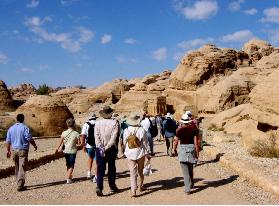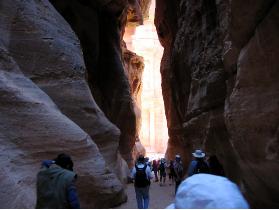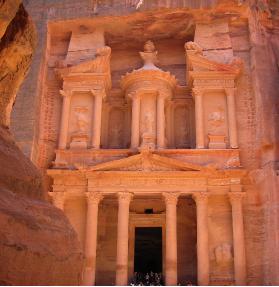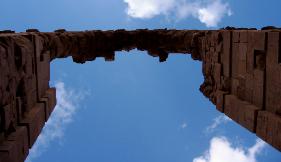 |
|
Israel Journal COLLEEN TINKER |
||||
NUMBER 8 — TUESDAY, NOVEMBER 4, 2008
Pondering Petra
What a day! I’m sitting in the Movenpick hotel in Petra attempting to recount our day, simultaneously keeping an eye on the election coverage on TV while waiting for dinner.
We spent the day seeing Petra. Petra has recently been named one of the Seven Wonders of the World. It was unknown to the Western world for centuries, but it is an ancient civilization originally built by the Nabateans in the fourth century BC. It was added to and built upon subsequently by the Greeks and also by the Romans.
Petra is nearly inaccessible, hidden away in the hills with a narrow entry of about a mile that is flanked by unbelievably tall cliffs. The entry passageway into Petra is paved in many places by the Roman paving stones that have been there for more than a thousand years. These Roman pavers, our guide told us, were laid over a lower layer of the original Nabatean paving. Much of the road is paved with a more modern concrete—laid, it turns out, for the filming of Raiders of the Lost Ark.
This hidden city is remarkable for its amazing structures carved literally into the sides of the hills with rooms chiseled out of the limestone. There are hundreds of cliff carvings, some merely holes leading into caves, others structural wonders complete with classical pilasters (pillars that are not free-standing but are carved in high relief out of the side of the rock), friezes, lintels, and carvings of classical mythological figures and designs from four different civilizations: Nabatean, Greek, Roman, and Egyptian—all done by the Nabateans and all dating within 350 years of each other, from the late 4th century BC to the early 3rd century BC.
The surprise for me was that the surviving structures are all tombs! The places where the Nabateans lived was destroyed in a great earthquake (many serious earthquakes have struck Petra over the centuries).
In addition to the breath-taking hillside structures (which, incidentally, people are free to explore and walk into—with the exception of the largest and most elaborate of them called The Treasury because of the faulty assumption on the part of the 19th century occupying British to be the hiding place of great treasure) there is the marketplace of ancient Petra. The marketplace has a central street paved with original Roman pavers and several buildings which are constructed, not carved out of the mountain. In every case, however, these buildings are in the process of being excavated and restored. A huge temple to Zeus was discovered by an archaeologist from Brown University in 1992, and its columns are being re-assembled, its stairways uncovered, and surprisingly, there is a small theater at the west end of the temple.
There are other buildings also being excavated and restored. One is a temple to yet another deity, and another is a 6th century Byzantine Christian church. This church was also discovered in the 1990’s, and a remarkable set of mosaics still is mostly intact down the outside aisles of the church. An ancient, extremely well-preserved baptismal font is being excavated in this church as well.
There is an outdoor theater in Petra that sat 5,000 people. Basing figures on the size of the amphitheater, experts estimate that Petra used to house 25,000 to 30,000 citizens.
Petra, Gary told us, has little biblical significance. What little reference we may have to this city is in the book of Obadiah. First, Obadiah spoke against the people of Edom—and Petra is in the ancient land of Edom. Obadiah prophecies God’s destruction of Edom. In Obadiah :2-3 (there is only one chapter in Obadiah) it says, “See, I will make you small among the nations; you will be utterly despised. The pride of your heart has deceived you, you who live in the clefts of the rocks and make your home on the heights, you who say to yourself, ‘Who can bring me down to the ground?’”
Gary said that obviously we can’t know for sure, but since Petra is in the ancient land of Edom and they clearly lived in the rocks, Obadiah’s prophesy may have been against the inhabitants of Petra. Some people hypothesize that Petra is the place where Jews will flee to find protection during the tribulation in fulfillment of Revelation 12:16 where it says the earth helps the woman by opening its mouth and swallowing the river that the dragon spews out to drown the woman.
Gary said that the Bible makes no indication that Petra is the place the Jews will run to for refuge; that notion, he said, is merely the product of the imagination of some prophecy teachers!
It was a tiring and astonishing day seeing the massive and intricate construction done millennia ago, but I find myself in awe of the eternal, sovereign power of God who knew in advance that a sophisticated civilization would live in those massive and beautiful limestone mountains. He also knew in advance that they would disappear—and all of this is for His glory.
There’s no second-guessing God. He hears each of us and calls and cares for each of us—and “He determined the times set for [every nation of men] and the exact places where they should live. God did this so that men would seek him and perhaps reach out for him and find him, though he is not far from each one of us” (Acts 17:26-27).
And on that note, I’m going to sign off and go eat dinner. Richard and I are joining you all in praying about the election—but nothing surprises God. I find great comfort in that knowledge.
Copyright 1999-2008 Graphics Studio, Redlands, CA USA. All rights reserved. Revised November 17, 2008. Use of this site and forum signifies your acceptance of the Terms and Conditions. Send comments and questions to formeradventist@gmail.com

 Our group catches the
Our group catches the The Treasury was an elaberate tomb for a wealthy Nabatean living in Petra between the 4th and 3rd centuries B.C.
The Treasury was an elaberate tomb for a wealthy Nabatean living in Petra between the 4th and 3rd centuries B.C. The main road through Petra is still paved with Roman stones. A temple in honor of Zeus is on the left.
The main road through Petra is still paved with Roman stones. A temple in honor of Zeus is on the left. A very tall arch remains even after a devestating earthquake destroyed the city of Petra.
A very tall arch remains even after a devestating earthquake destroyed the city of Petra.